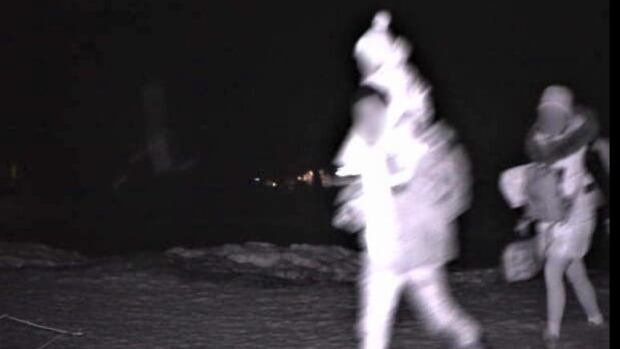Global Courant 2023-04-15 00:28:07
While the spotlight was on the Akwesasne border region following the deaths of six foreigners and two Canadian children in the St. Lawrence River, smuggling networks continued to move people overland through a region east of the Kanien’kehá:ka (Mohawk)- community, USA. court records show.
Canadian authorities recovered the bodies of four members of an Indian family and a Romanian couple with their two Canadian-born children from the St. Lawrence River on March 30 and 31. The two families are said to have died in an illegal crossing to the US. by boat on the St. Lawrence River through Akwesasne.
Recent filings in U.S. federal court show that the sudden focus on the irregular movement of people from Canada to the U.S. has done little to curb the general human smuggling traffic flowing through a border area between Canada and New York State.
This area, known to US border authorities as the Swanton sector, runs along the border between Ontario, Quebec and the state of New York and Vermont. It is the most active region for north-south irregular traffic along the Canada-US border. The highest level of irregular traffic flows between Quebec and upstate New York, according to US border data.
The Royal Canadian Mounted Police (RCMP) says it has seen an increase in southbound irregular traffic in recent months. In a statement, federal police said many people arrive on flights to Toronto or Montreal with visitor status and then attempt to cross the border.
“We also note that some individuals who have entered Canada illegally between designated entry points, for example on Roxham Road, are now attempting to enter the US in the same illegal manner,” said Cpl. Tasha Adams, with RCMP’s C Division in Quebec, said in an emailed statement.
The RCMP is responsible for patrolling the borders between official ports of entry.
A border camera attached to a tree along the border between Quebec and New York. (CBC News)
The recent tragedy on the river has not slowed down the smugglers.
Within a week of River’s death, between April 7 and 11, U.S. border authorities arrested at least 30 people who had crossed the Quebec-New York border beyond Akwesasne’s eastern borders, according to records.
In the span of about 11 hours, on April 9, U.S. border agents arrested 15 people who had crossed south at two border points between Fort Covington and Champlain, NY
The first group crossed over on the night of April 8 when cameras and sensors from the RCMP and US Border Patrol captured five to 10 people moving through undergrowth and farmland to the US around the town of Fort Covington, NY, which is about 15 miles away. . east of Akwesasne, according to records.
Officers then began to stake out the area. At 1:15 a.m. on April 9, they saw a vehicle slowly rolling down a road parallel to the border and stopped momentarily as two people emerged from the shadows and jumped inside. Officers stopped the vehicle with two Mexican nationals wearing muddy clothes in the passenger seats.
Agents then found seven more Mexican nationals hiding in the undergrowth in the same area.
Wet, muddy clothes and shoes were left behind by individuals who irregularly entered the US in September 2022 through forests along the border between Quebec and New York. (CBC News)
Hours later, about 40 miles east of Fort Covington, at around 11:35 p.m., U.S. Border Patrol agents stopped a Ford F-150 pickup truck with six Mexican nationals “stacked on top of each other in the backseat.”
One of the male Mexican nationals told officers that the smuggling attempt was organized by someone in Canada and that he had flown to Toronto a week earlier.
He said he paid $2,500 US to the Canadian “facilitator” through a money transfer. He was picked up by a driver in Toronto and then taken to Montreal before heading south to the border. He told officers he was expected to pay an additional $2,500 once he crossed, according to court documents.
The driver of the vehicle, who was also a Mexican citizen and an illegal resident of the US, said this was his fourth border crossing and he was paid US$1,000 per trip.
RCMP has ‘limited’ legislative tools
On April 11, about 30 miles east of Fort Covington, sometime after 11:30 p.m., U.S. border agents stopped a Chevrolet Silverado carrying six Mexican nationals who had just entered the U.S. from Canada.
One of the Mexican nationals, a man, told border agents that the border smuggling attempt was brokered by a man named “Alex” in Canada. He said he paid $3,000 US upfront and was expected to pay another $3,000 once he got to his destination in Maryland.
The driver was from El Salvador and, according to the court, had no papers to legally live in the US.
Adams said there is little the RCMP can do even if it intercepts individuals aiming for the border. If the individuals are legally in Canada, the best thing the Mounties would do is take them away from the international border, Adams said.
“We are trying to detect and deter this movement, but the reality is that the legislative tools at our disposal are limited,” Adams said in the emailed statement.
“We often transport these people elsewhere because we want to prevent them from entering the US illegally. We inform our partners at (US Border Patrol) and it becomes a continuous cycle.”








